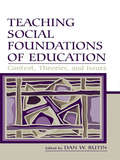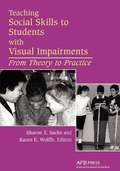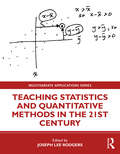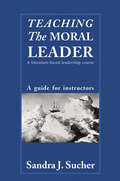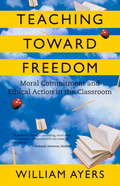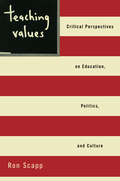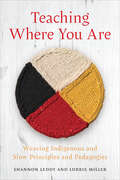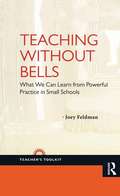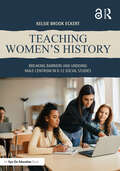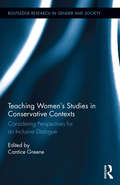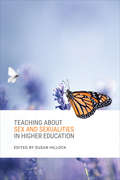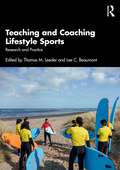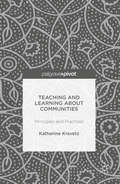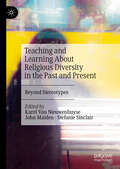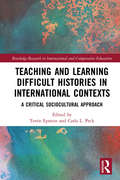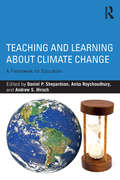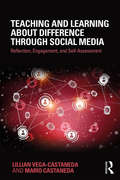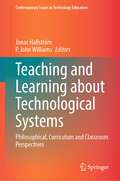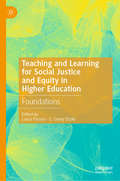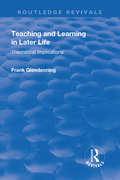- Table View
- List View
Teaching Social Foundations of Education: Contexts, Theories, and Issues (Sociocultural, Political, and Historical Studies in Education)
by Dan W. ButinThis book, the first comprehensive, critical examination of the theory and pedagogy of the field of social foundations of education and its relevance and role within teacher education:*Articulates central questions in the field--such as "What is social foundations?"; "Is there a social foundations canon?"; "Is it possible to teach for social justice?"; "What is student resistance?";*Explores the limits and possibilities of teaching social foundations of education;*Provides strong arguments for the continued relevance of the discipline for teacher education;*Features a variety of clearly presented, theoretically grounded models for teaching social foundations within teacher education programs--including aesthetic education, critical theory, and eco-justice perspectives, the use of community-based oral histories, and experiential learning activities;*Provides concrete examples, actual syllabi, and a host of additional resources to help faculty teach, publish, and do research; and*Proposes new directions for research and dialogue within the field.This volume is an ideal entrance into the field for graduate students, junior faculty, and professors from other areas of education who are teaching in the social foundations field for the first time.
Teaching Social Skills to Students with Visual Impairments: From Theory to Practice
by Karen E. Wolffe Sharon Z. SacksHow do children become social beings? When a child is unable to observe visually and imitate how other people react and interact, this complex developmental process can become fragmented and incomplete. As a result, providing specific information, direct instruction, and opportunities for social interaction to children who are blind or visually impaired is critical to their growth and education. Edited by two groundbreaking educators and researchers, with contributions from other outstanding educators and researchers in this area, Teaching Social Skills to Students with Visual Impairments explores what theory can tell us about how children who are visually impaired become socially skilled individuals. It then presents a compendium of techniques and strategies for helping youngsters, from preschoolers through young adults, including those with additional disabilities, develop and refine social skills.
Teaching State History: A Guide to Developing a Multicultural Curriculum
by Ava L. Mccall Thelma RistowThe text offers specific examples of the curricular framework in action, portraying teaching strategies and students' responses to topics that range from the process of becoming a state, the first inhabitants of the state, state government, state industries, and family histories to even more challenging subjects including treaties with Native Americans and the struggle for voting rights.
Teaching Statistics and Quantitative Methods in the 21st Century (Multivariate Applications Series)
by Joseph Lee RodgersThis work, which provides a guide for revising and expanding statistical and quantitative methods pedagogy, is useful for novice and seasoned instructors at both undergraduate and graduate levels, inspiring them to use transformative approaches to train students as future researchers. Is it time for a radical revision in our pedagogical orientation? How are we currently teaching introductory statistics and quantitative methods, and how should we teach them? What innovations are used, what is in development? This ground-breaking edited volume addresses these questions and more, providing cutting-edge guidance from highly accomplished teachers. Many current textbooks and syllabi differ in only superficial ways from those used 50 years ago, yet the field of quantitative methods—and its relationship to the research enterprise—has expanded in many important ways. A philosophical axiom underlying this book is that introductory teaching should prepare students to potentially enter more advanced quantitative methods training and ultimately to become accomplished researchers. The reader is introduced to classroom innovation, and to both pragmatic and philosophical challenges to the status quo, motivating a broad revolution in how introductory statistics and quantitative methods are taught. Designed to update and renovate statistical pedagogy, this material will stimulate students, new instructors, and experienced teachers.
Teaching Statistics in School Mathematics-Challenges for Teaching and Teacher Education
by Gail Burrill Carmen Batanero Chris ReadingTeaching Statistics in School Mathematics-Challenges for Teaching and Teacher Education results from the Joint ICMI/IASE Study Teaching Statistics in School Mathematics: Challenges for Teaching and Teacher Education. Oriented to analyse the teaching of statistics in school and to recommend improvements in the training of mathematics teachers to encourage success in preparing statistically literate students, the volume provides a picture of the current situation in both the teaching of school statistics and the pre-service education of mathematics teachers. A primary goal of Teaching Statistics in School Mathematics-Challenges for Teaching and Teacher Education is to describe the essential elements of statistics, teacher's professional knowledge and their learning experiences. Moreover, a research agenda that invites new research, while building from current knowledge, is developed. Recommendations about strategies and materials, available to train prospective teachers in university and in-service teachers who have not been adequately prepared, are also accessible to the reader.
Teaching That Changes Lives: 12 Mindset Tools for Igniting the Love of Learning
by Marilee G. AdamsBuilding on the success of her classic, bestselling book, Change Your Questions, Change Your Life, Marilee Adams shows how, by adopting a new mindset, teachers can rekindle their love of teaching and ignite their students with a love of learning.Teaching That Changes Lives is a transformational and practical guide that will enable teachers to make an authentic difference with their students and avoid succumbing to the myriad pressures and challenges of their jobs. Using the storytelling format that proved so successful in her previous book, Adams tells how Emma, a sixth-grade teacher on the verge of quitting her job, learns to cultivate what Adams calls the “Learner Mindset”— having the discipline, curiosity, and courage to consistently ask growth-oriented, open-minded questions of oneself and others—and to avoid the close-minded and critical “Judger Mindset.” Emma transforms her classroom, her relationships with her colleagues, and, most importantly, her students' eagerness for learning and achievement. Teaching is more than imparting facts and skills—it's preparing students for the test of life. Featuring an innovative, easy-to-follow workbook and access to a Learner Mindset online mini-course, this inspiring book will ensure that teachers and students alike become creative, resilient problem solvers, bridge builders, and lifelong learners.
Teaching The Moral Leader: A Guide for Instructors
by Sandra J. SucherThis book is a comprehensive, practical manual to help instructors integrate moral leadership in their own courses, drawing from the experience and resources of the Harvard Business School course 'The Moral Leader', an MBA elective taken by thousands of HBS students over nearly twenty years. Through the close study of literature--novels, plays, and historical accounts-- followed by rigorous classroom discussion, this innovative course encourages students to confront fundamental moral challenges, to develop skills in moral analysis and judgment, and to come to terms with their own definition of moral leadership. Using this guide's background material and detailed teaching plans, instructors will be well prepared to lead their students in the study of this vital and important subject. Featuring a website to run alongside that links the manual with the textbook and provides a wealth of extra resources, including on-line links to Harvard Business School case studies and teaching notes this manual forms a perfect complement to The Moral Leader core text also by Sandra Sucher. The detailed and hands-on nature of the guide makes it possible for instructors, with or without a specialized background, to replicate the 13-session Harvard Business School course, or to integrate moral leadership into an existing course, or as a module, or as stand-alone sessions. The manual presents flexible class plans, easily adaptable to a wide variety of business and academic topics. It suggests how to adapt the course to other settings, provides supporting materials, and reviews the approach to teaching "The Moral Leader," differentiating it from other literature-based courses. The author, a Harvard Business School professor with a successful record in teaching this course, also brings into the text the kind of real world understanding of effective leadership development that comes from decades of experience as a high level corporate executive. An accompanying student book, focused on class preparation and the context of each work, helps students address questions like: What is the nature of a moral challenge? How do people "reason morally"? How do leaders – formal and informal – contend with the moral choices they face? How is moral leadership different from leadership of any other kind? Struggling with these questions, both individually and as members of a vibrant learning community, students internalize moral leadership concepts and choices, and develop the skills to pursue it in their careers and personal lives.
Teaching Toward Freedom: Moral Commitment and Ethical Action in the Classroom
by William AyersAyers (education, U. of Illinois at Chicago), who has taught for 30 years, feels that teachers are "moral actors," that teaching involves "moral commitment and ethical action," and that these elements are at the core of real education. He advises teachers to accept their calls as instigators of freedom and enlightenment, and act as coworkers with students. Using examples from the academe, including poetry, history, and fiction, as well as popular culture, he examines what can go right, and wrong, and how teachers can be liberators or tyrants, depending on how they perceive their core missions and on how well they understand their students as individuals. Ayers includes neither a bibliography nor an index. Annotation ©2004 Book News, Inc. , Portland, OR (booknews. com)
Teaching Trump: Critical Issues in History and Civics Education
by Fritz FischerThis book makes the case for teaching and engaging with the Trump presidency as US political history. Asking questions about how and when Trump’s presidency should be studied posits that history teachers must engage with this history now. The author points to the events that the January 6th Commission called a “stain on our history” and makes the argument that these events, if ignored, could stain the idea of history itself, shrouding it in a mythical haze and relegating history teachers to merely marginalized storytellers. As such, it offers ideas on engaging students with the facts and sources of the Trump presidency and placing Trump in the larger context of American political history. It specifically centers the notion of “historical thinking” as a guiding principle for the teaching of history and the study of the Trump presidency in particular. This book bridges the gap between the controversial events and rhetoric of Donald Trump’s first administration and the importance of contextualizing his presidency in the history classroom. It will appeal to educators, scholars, and researchers with interests in history education and teaching, those interested in civic education and social studies, as well as anyone interested in the future of teaching history and civics.
Teaching Values: Critical Perspectives on Education, Politics, and Culture
by Ron ScappIn Teaching Values, Ron Scapp wrests the discussion of values and values-based education away from traditionalists who have long dominated educational debates. While challenging the Right's domination of the discussion of values education, Scapp examines some issues not typically raised by educators and critics on the Left, including the positive role of citizenship and national identity in U.S. education and culture.
Teaching Where You Are: Weaving Indigenous and Slow Principles and Pedagogies
by Lorrie Miller Shannon LeddyTeaching Where You Are offers a guide for non-Indigenous educators to work in good ways with Indigenous students and provides resources across curricular areas to support all students. In this book, two seasoned educators, one Indigenous and one settler, bring to bear their years of experience teaching in elementary, secondary, and post-secondary contexts to explore the ways in which Indigenous and Slow approaches to teaching and learning mirror and complement one another. Using the holistic framework of the Medicine Wheel, Shannon Leddy and Lorrie Miller illustrate the ways in which interdisciplinary thinking, a focus on experiential learning, and the thoughtful application of the 4Rs – Respect, Relevance, Reciprocity, and Responsibility – can bring us back to the principle of teaching people, not subjects. Bringing forth the ways in which colonialism and cognitive imperialism have shaped Canadian curriculum and consciousness, the book offers avenues for the development of decolonial literacy to support the work of Indigenizing education. In considering the importance of engaging in decolonizing and Indigenizing approaches to education through Slow and Indigenous pedagogies using the lens of place-based and land-based education, Teaching Where You Are presents a text useful for teachers and educators grappling with the ongoing impacts of colonialism and the soul-work of how to decolonize and rehumanize education in meaningful ways.
Teaching With Love And Logic: Taking Control Of The Classroom
by Jim Fay Charles FayThe exercises and tips contained in this book will help teachers orient students toward being internalized in their discipline rather than depending upon external controls--resulting in easier classroom management and more quality teaching time. Jim and Charles Fay will teach you how to effectively manage your classroom through shared control, choices within limits and the importance of relationships. For teachers in grades K-12.
Teaching Without Bells: What We Can Learn from Powerful Practice in Small Schools (Teacher's Toolkit Ser.)
by Joey FeldmanSmall schools have the potential to fundamentally change the conditions of teaching and learning when practitioners deliberately exploit smallness and recognize relationships as a powerful mechanism for improving student achievement. Feldman explains the dynamics of teaching in a small high school--what having fewer students in a school affords teachers, as well as the challenges for teaching that exist alongside the opportunities--based on research, teacher interviews, and the author's own experiences as a practitioner in both small and large schools. This book is for any educator or researcher who wants to better understand the kind of promising practices and professional norms that have been nurtured under conditions of smallness. Being informed about what is possible and often facilitated in small schools will enable educators to better reflect on their own practice, consider certain pedagogical strategies against the organizational characteristics of schools, and make educated career choices. Armed with this information, educators and researchers can become more focused in their advocacy efforts and more empowered to improve our public high schools whether by redesigning them into small schools or by transplanting and translating small school practices and strategies."
Teaching Women's History: Breaking Barriers and Undoing Male Centrism in K-12 Social Studies
by Kelsie Brook EckertTeaching Women’s History: Breaking Barriers and Undoing Male Centrism in K-12 Social Studies challenges and guides K-12 history teachers to incorporate comprehensive and diverse women’s history into every region and era of their history curriculum.Providing a wealth of practical examples, ideas, and lesson plans – all backed by scholarly research – for secondary and middle school classes, this book demonstrates how teachers can weave women’s history into their curriculum today. It breaks down how history is taught currently, how teachers are prepared, and what expectations are set in state standards and textbooks and then shows how teachers can use pedagogical approaches to better incorporate women’s voices into each of these realms. Each chapter explores a major barrier to teaching an inclusive history and how to overcome it, and every chapter ends with an inquiry-based lesson plan on women or using women's sources which stands counter to the way curriculum is traditionally taught, a case in point that tasks readers to realize how women have been integral to every period of history.With expert guidance from an award-winning social studies teacher, this guidebook will be important reading for middle and high school history educators. It will also be beneficial to preservice teachers, particularly within Social Studies Education and Gender Studies.Additional resources for educators are available to view at www.remedialherstory.com.
Teaching Women's Studies in Conservative Contexts: Considering Perspectives for an Inclusive Dialogue (Routledge Research in Gender and Society #48)
by Cantice GreeneWomen’s Studies is a field that inspires strong reactions, both positive and negative, inside and outside of the classroom. The field, partly due to its activist origins, is often associated with liberal ideology and is therefore chided by students and others who identify as conservative. The goal of this book is to introduce conservative perspectives into the issues of gender, sexuality, race, and power that are topics of teaching and discussion in women’s studies courses. The book also aims to provide examples of pathways by which conservative students and scholars can engage the field of women’s studies, not as opponents, but as contributors. Contributors including administrators, activists, scholar-teachers, artists, and ministers come together in this collection to engage in writing and response and to add their approaches to teaching and administering women’s studies on their campuses.
Teaching about Sex and Sexualities in Higher Education
by Susan HillockTeaching about Sex and Sexualities in Higher Education argues that much more can be done in teaching about sex and sexuality in higher education. This edited collection provides key information on professional training and support, and acts as a crucial resource on sex, sexuality, and related issues. With a focus on diversity, this book features expert contributors who discuss key concepts, debates, and current issues across disciplines to help educators improve curriculum content. This collection aims to provide adequate and appropriate sex education training and opportunities to educators so that they may explore complex personal and emotional issues, build skills, and develop the confidence necessary to help others in their respective fields.
Teaching and Coaching Lifestyle Sports: Research and Practice
by Thomas M. Leeder Lee C. BeaumontLifestyle sports have witnessed unprecedented growth in recent years, with it being accepted that these activities can contribute significantly to national sport and physical activity agendas, appeal to contemporary youth culture, and provide an alternative to mainstream achievement sports within school physical education. However, this popularity has led to increased professionalisation and institutionalisation, meaning there is now a demand for educated teachers and coaches to facilitate learning through effective pedagogical approaches. Consequently, Teaching and Coaching Lifestyle Sports: Research and Practice is the first book of its kind to provide both theoretical and empirical insights into the process and practice of teaching and coaching lifestyle sports across school, community, and high-performance sport contexts.Drawing upon a variety of lifestyle sports including skateboarding, freestyle BMX, parkour, and freeskiing, this book develops readers’ understanding and conceptualisation of the issues, challenges, and opportunities associated with teaching and coaching lifestyle sports. Each chapter, grouped via a broad focus on either teaching or coaching, offers novel perspectives towards current trends, pedagogical approaches, and ‘steps forward’ in relation to lifestyle sports within physical education and sport coaching. This book covers contemporary and important topics within lifestyle sports, such as coach development, enhancing youth sport participation, facilitating athlete learning, and creating a ‘meaningful’ physical education experience. Drawing upon global examples, each chapter generates new knowledge associated with the teaching and coaching of lifestyle sports, while critically discussing areas for future research alongside practical implications for teachers, coaches, and sports organisations. Teaching and Coaching Lifestyle Sports: Research and Practice is a valuable resource for researchers and academics, in addition to students and practitioners, who are currently working across the overlapping fields of physical education, sport coaching, sport development, and leisure studies, or have an interest in lifestyle sports.
Teaching and Learning About Communities
by Katharine KravetzThis book provides a rationale and conceptual framework for teaching and learning about community. It focuses on what community means in multiple contexts, outlines the needs and assets of communities, and discusses different approaches to community change. The book provides real life examples of integrated approaches to community transformation as well as sample exercises to promote a better understanding of community challenges and approaches to solve them. Applicable in the classroom and in actual community work, the book's conceptual and practical approach can be used to study community, or to integrate community issues into learning in virtually any field.
Teaching and Learning About Religious Diversity in the Past and Present: Beyond Stereotypes
by John Maiden Karel Van Nieuwenhuyse Stefanie SinclairThis edited book explores examples of different ways in which societies and individuals have dealt with the concepts of religious diversity, toleration and peace-making in politics and law, and how these examples can inform educators and learners in (in- and non-)formal education today. Chapters introduce and analyse nine key documents: the Capitulations of Granada (1492), the Confederation of Warsaw (1573), the Peace of Westphalia (1648), the Royal Charter of Rhode Island (1663), the Declaration of the Rights of Man and of the Citizen (1789), the European Convention of Human Rights (1950), the Belfast/ Good Friday Agreement (1998), the Ohrid Framework Agreement (2001) and the Mardin Declaration (2010). In addition to explaining how each document manages toleration and peace, the authors also provide ‘clippings’, short visual and textual excerpts relating to the document under discussion. These aim to challenge thinking about the historical document and its potential significance for the present. The book’s contributors consider the past as a source of inspiration for learning in formal and informal educational contexts such as classrooms, museums and youth work. It will be of interest to teachers and scholars in history, citizenship, philosophy, ethics and religious education in schools and beyond.
Teaching and Learning Difficult Histories in International Contexts: A Critical Sociocultural Approach (Routledge Research in International and Comparative Education)
by Terrie Epstein Carla L. PeckGrounded in a critical sociocultural approach, this volume examines issues associated with teaching and learning difficult histories in international contexts. Defined as representations of past violence and oppression, difficult histories are contested and can evoke emotional, often painful, responses in the present. Teaching and learning these histories is contentious yet necessary for increased dialogue within conflict-ridden societies, reconciliation in post-conflict societies, and greater social cohesion in long-standing democratic nations. Focusing on locations and populations across the globe, chapter authors investigate how key themes—including culture, identity, collective memory, emotion, and multi-perspectivity, historical consciousness, distance, and amnesia—inform the teaching and learning of difficult histories.
Teaching and Learning about Climate Change: A Framework for Educators
by Daniel P. Shepardson, Anita Roychoudhury and Andrew S. HirschResponding to the issues and challenges of teaching and learning about climate change from a science education-based perspective, this book is designed to serve as an aid for educators as they strive to incorporate the topic into their classes. The unique discussion of these issues is drawn from the perspectives of leading and international scholars in the field. The book is structured around three themes: theoretical, philosophical, and conceptual frameworks for climate change education and research; research on teaching and learning about global warming and climate change; and approaches to professional development and classroom practice.
Teaching and Learning about Difference through Social Media: Reflection, Engagement, and Self-assessment
by Lillian Vega-Castaneda Mario CastanedaTeaching and Learning about Difference through Social Media considers the role social media has played in prompting public conversations about difference and diversity, including issues relating to ethnicity, race, religion, political affiliation, gender, and sexual orientation. These issues are addressed in the context of the present political climate. They are also examined with respect to occurrences of hate and violence, including hate crimes and mass fatality events. Using a historical and socio-cultural approach to how we look at these significant issues in the USA, the authors examine the ways difference and diversity are represented in online interactions via social media. In order to encourage a more informed dialogue and critical conversation with students, each chapter includes: discussion questions, self-reflection and self-assessment activities, and suggestions for further reading,. Ideal for courses in diversity and social justice education and beyond, this content and practice-based text integrates the identification of issues of difference and diversity with suggestions for how we can address these issues in the social media age.
Teaching and Learning about Technological Systems: Philosophical, Curriculum and Classroom Perspectives (Contemporary Issues in Technology Education)
by P. John Williams Jonas HallströmThis book discusses the teaching and learning about technological systems in technology education and adjacent curriculum areas. It describes, analyzes and synthesizes contemporary research on technological systems in technology education. By delving into the philosophy, sociology and history of technology, technology education and the learning and teaching of technological systems, it summarizes prior research and analyzes new research. This book thereby serves as a resource and reference work for professionals in this area of research and education.
Teaching and Learning for Social Justice and Equity in Higher Education: Foundations
by Laura Parson C. Casey OzakiThis book is the first of three edited volumes designed to reconceptualize teaching and learning in higher education through a critical lens, with this inaugural publication focusing on the fundamentals behind the experience. Chapter authors explore recent research on the cognitive science behind teaching and learning, dispel myths on the process, and provide updates to the application of traditional learning theories within the modern, diverse university. Through reviews of fundamental theories of teaching and learning, together with specific classroom practices, this volume applies social justice principles that have been traditionally seen as belonging to K-12 or adult education to higher education.
Teaching and Learning in Later Life: Theoretical Implications (Studies In Educational Gerontology #Vol. 4)
by Frank GlendenningThis title was first published in 2000: This collection of papers examines the development of education for older adults against the background of an ageing population and the challenge of lengthening life expectancy. It brings together contributions from the UK and Canada. The book analyzes the current situation, reviews trends and perspectives and discusses educational gerontology and its relationship to older adults in the approach to the 21st century. There is a call for recognition of the status of older people in education on the basis of social justice, using the notions of equal opportunity, access to democratic participation, respect for persons and the status of equal citizenship. There is also recognition of the need to empower older adults by facilitating a sense of autonomy and self-determination. Educational gerontology is examined in the context of critical theory and social gerontology, raising a number of questions necessary to the understanding of critical educational gerontology. The book seeks to promote a positive attitude to ageing and concludes by drawing out implications for the future.
